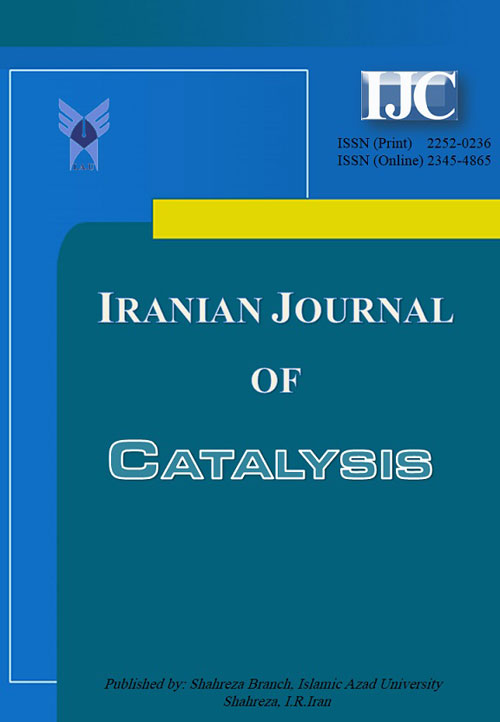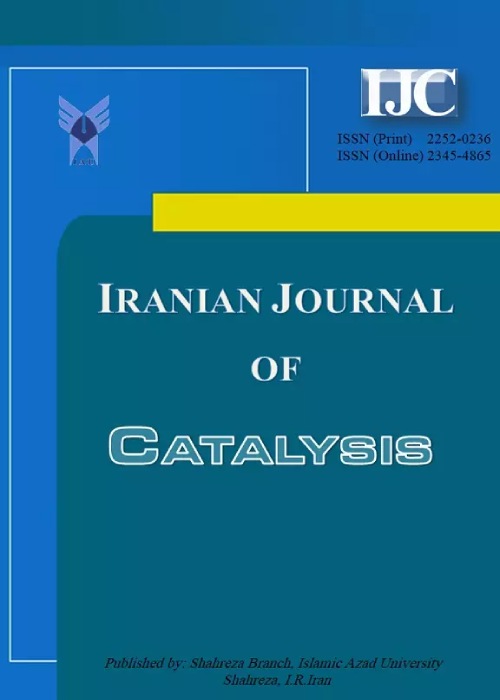فهرست مطالب

Iranian Journal of Catalysis
Volume:7 Issue: 1, Winter 2017
- تاریخ انتشار: 1396/02/10
- تعداد عناوین: 11
-
-
Pages 1-9The Fe-MCM-22 zeolite was found to be an efficient solid heterogeneous catalyst for synthesis of dihydropyrano [2,3-c] pyrazoles via one pot four component reaction of ethyl acetoacetate, hydrazine hydrate, aromatic aldehyde and malononitrile in aqueous alcohol. The catalyst was synthesized by hydrothermal method under autogenous pressure and modified by Fe (III) ion exchange. The prepared catalyst was characterized by X-ray diffraction (XRD), Scanning Electron Microscopy-Energy Dispersive spectroscopy (SEM-EDS), Fourier Transform Infrared Spectroscopy (FT-IR), and Brunauer-Emmett-Teller (BET) measurement technique. This ecofriendly protocol provides several advantages such as use of an inexpensive catalyst, short reaction time, mild reaction condition, simple work-up, good to excellent yield and reusability of the catalyst.Keywords: Fe-MCM-22 zeolite, Multicomponent synthesis, Heterogeneous catalyst, Dihydropyrano [2, 3-c] pyrazoles
-
Pages 11-20Alkanedisulfamic acid functionalized silica-coated magnetic nanoparticles (ADSA-MNPs) were used as effective, low-cost and reusable solid heterogeneous nanomagnetic catalysts for conversion of aldehydes and ketones to corresponding gem-dihydroperoxides and 1,2,4,5-tetraoxanes using aqueous hydrogen peroxide (30% w/w in H2O) at room temperature. These compounds are important key intermediates in preparation of anti-malaria drugs. The reactions proceeded in high rates and excellent yields. Since the catalyst was separated facilely from the reaction mixture by an external magnet and was reused six times without considerable loss of catalytic activity, this methodology is environmentally friendly. It is notable that it is the first report on using a nanocatalyst in the synthesis of gem-dihydroperoxides and 1,2,4,5-tetraoxanes from aldehydes and ketones up to now.Keywords: Gem-dihydroperoxide, 1, 2, 4, 5-tetraoxanes, Alkanedisulfamic acid functionalized silica-coated magnetic nanoparticles, aldehydes, Ketones, Hydrogen peroxide
-
Pages 21-26Nanoporous sodium montmorillonite clay (Na+MMT) was used as a support for the immobilization of 1-methyl-3-(trimethoxysilylpropyl)-imidazolium hydrogen sulfate (Na+MMT-[pmim]HSO4). This catalyst showed excellent catalytic activity for the preparation of 2-amino-3-cyano-5-oxo-5,6,7,8-tetrahydro-4H-benzopyrans via three-component reactions between aldehydes, dimedone and malononitrile. The procedure gave the products in high yields within short reaction times. Also, this catalyst can be reused at least for five times without loss of its catalytic activity. All the products were characterized using melting point, IR, 1H NMR and 13C NMR and were identified by comparison of their spectra with those of authentic samples.Keywords: Na+-montmorillonite, Clay, Immobilization of ionic liquid, Multi-component reactions, Pyran, 2-Amino-4H-pyrans
-
Pages 27-35The reaction of 3-chloropropyl boehmite nanoparticles with caffeine and sulfuric acid afforded BNPs-3-propyl-imidazolopyridinium hydrogen sulfate [BNPs-Caff]HSO4 as a new BNPs-supported ionic liquid (IL) catalyst. [BNPs-Caff]HSO4 proved to be an efficient heterogeneous catalyst for the synthesis of pyrazolopyranopyrimidines via a one-pot four-component reaction of hydrazine hydrate, ethyl acetoacetate, barbituric acid, and an aldehyde. The attractive features of this method are simple procedure, clean reaction, use of a reusable catalyst, easy workup, and performing a multi-component reaction (MCR) in water. A number of synthesized compounds were screened for their in vitro anti-bacterial activities against the Gram-positive and Gram-negative bacteria using a well-diffusion method.Keywords: Boehmite nanoparticles, Reusable catalyst, Caffeine, Pyrazolopyranopyrimidine, Anti-bacterial activity
-
Pages 37-46The photocatalytic activity of nano-Bi2O3 was evaluated in degradation of rhodamine B (RhB) as a model of dye pollutant from waste waters. Nano sized Bi2O3 was synthesized using the chemical precipitation method. The as-prepared sample was characterized by X-ray diffraction (XRD), scanning electron microscopy (SEM) and Fourier transform infrared spectrometry (FT-IR). Structural analysis revealed that Bi2O3 contains a unique well-crystallized phase and the average crystallite size of 22.4 nm. The SEM analysis revealed that the size of Bi2O3 particles was mainly in the range of 16-22 nm. Response surface methodology was applied to design experiments and to optimize the photocatalytic process. A second order model was developed and a good correlation was found between experimental and predicted responses, confirming the reliability of the model. The optimal condition for maximum degradation of values of RhB resulted in initial concentration, irradiation time, initial pH and catalyst dosage of 12.5 mg.L-1, 120 min, 4.6-7 and 0. 75 g.L-1, respectively. The Bi2O3 nanoparticles exhibited an efficient ultraviolet photocatalytic activity so that under optimal condition more than 95% of Rhodamine B was decolorized. The Pareto analysis indicated that the order of relative importance of the input variables on the dye degradation efficiency is as follows: Bi2O3 dosage > pH ≈ irradiation time >initial concentration of the RhB.Keywords: Nanoparticle, Bismuth nano oxide, photocatalytic dye degradation, Response surface methodology, Pareto analysis
-
Pages 47-52In this study, CuI nanoparticles as an efficient catalyst was used for the synthesis of 14-phenyl-8H-dibenzo[a,i]xanthene-8,13(14H)-diones using aldehydes, 2-naphthol and 2-hydroxynaphthalene-1,4-dione in aqueous media. In this study, it was found that water was the most effective solvent compared to others. Among several catalysts that were tested for this multi-component synthesis, CuI nanoparticles were the best catalyst with 4 mol% loading. The reusability of CuI nanoparticles was experienced for 6 times with a slightly decreased activity. The use of no hazardous organic solvent, atom economy, short reaction times, little catalyst loading, reusability of the catalyst and high yields of products are some of the important features of this protocol.Keywords: Dibenzoxanthene, CuI nanoparticles, Environmentally benign, Three-component reactions
-
Pages 53-59In the present study, the effects of calcium doping on the performance of the co-precipitated Cu-MgO catalysts prepared with different calcium loadings in the selective hydrogenation of furfuraldehyde were investigated. The results proved that the addition of this promoter had a remarkable impact on the catalytic performance. The conversion of furfuraldehyde enhanced up to 83% and the furfuryl alcohol selectivity remained above 96% over the run length on the promoted Cu-Ca-MgO catalyst. However, the conversion level decreased to 60% after 240 min of operation period which was still superior with respect to the negligible conversion with the non-promoted Cu-MgO catalyst.Keywords: Hydrogenation, Furfuraldehyde, Furfuryl alcohol, Cu-MgO, Calcium promoter, Biomonomer, Heterogeneous catalyst
-
Pages 61-68A Simple and efficient method for synthesis of tetrahydropyrimido[4,5-b]quinoline derivatives via three component reaction of aromatic aldehydes, dimedone and 6-amino uracil derivatives using a catalytic amount of sulfonic acid functionalized nanoporous silica (SBA-15-Pr-SO3H) is described. The advantages of this method are easy and clean work-up, high yield, mild reaction condition, reusable catalyst and environmentally benign solvents. Antibacterial and antifungal activities of synthesized compounds were measured against gram positive, gram negative bacteriaand fungus. Only compounds 4c and 4g showed activity against Staphylococcus aureus.Keywords: 4(6)-Amino uracil, aldehydes, Dimedone, SBA-15-Pr-SO3H, Multi-component reaction
-
Pages 69-73Titania nanotubes (TNT) prepared by anodization of Ti foils were used for water splitting in a standalone cell. The concentration polarization between the anode side (1M NaOH) and cathode side (0.5 M H2SO4) ensured that the water splitting reaction could take place with no external bias and separate H2 and O2 evolution could be achieved. The destruction of TNT structures under 365 nm UV irradiation as well as the absence of the stoichiometry between the anodic and cathodic gas collectors indicates the limits of the stability of TNT structures under these conditions.Keywords: TiO2, Photocatalysis, Solar energy materials, Corrosion, Instability, Surfaces
-
Pages 75-83This study introduces a green and efficient method for preparation of biologically-active substituted 4H-pyrans using the one-pot three-component reaction of aromatic aldehydes, dimedone and malononitrile in the presence of cobalt oxide nanoparticles. Co3O4 nanoparticles were used as an efficient catalyst for the synthesis of polyhydroquinoline derivatives by the reaction of aromatic aldehydes, ethyl acetoacetate, dimedone and ammonium acetate. The preparation and use of Co3O4 as a powerful and reusable nanocatalyst under solvent-free conditions is described. The catalyst was characterized by spectral techniques including XRD, FE-SEM, FT-IR, VSM, EDX and TEM analysis. This method offers the advantages of high yield, short reaction time, comfortable work-up and reusability of the catalyst.Keywords: One-pot, Nanocatalyst, Tetrahydrobenzopyran, Polyhydroquinoline, Solvent-free, Co3O4
-
Pages 85-88Meysam Yarie was born in 1987 in Malayer/ Hamedan, Iran. He received his B.Sc. in Applied Chemistry (2010) from Malek-Ashtar University of Technology and M.Sc. in Organic Chemistry (2012) from Kurdistan University under the supervision of Dr. Kamal Amani. He is currently working towards his Ph.D. under the supervision of Professor Mohammad Ali Zolfigol. His research interest is the synthesis, characterization and applications of nanomagnetic heterogeneous catalysts and nano ionic liquids and molten salts promoters in organic synthesis.Keywords: Anomeric based oxidation


